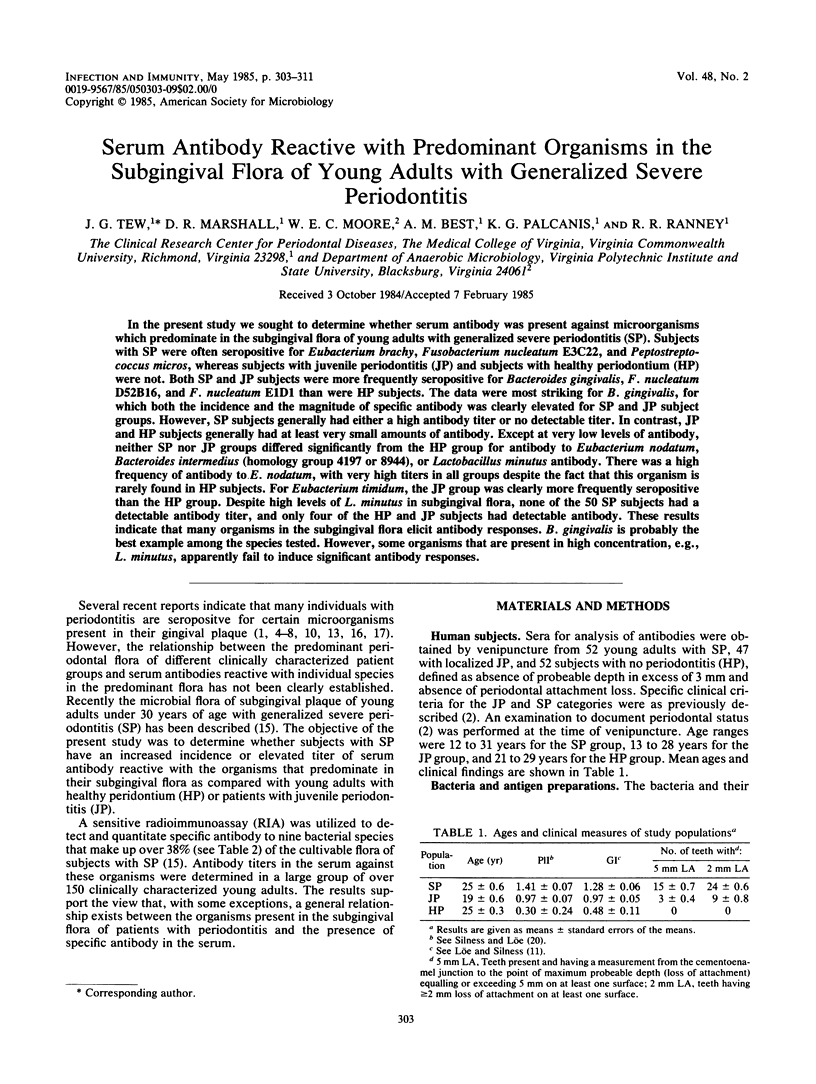Abstract
In the present study we sought to determine whether serum antibody was present against microorganisms which predominate in the subgingival flora of young adults with generalized severe periodontitis (SP). Subjects with SP were often seropositive for Eubacterium brachy, Fusobacterium nucleatum E3C22, and Peptostreptococcus micros, whereas subjects with juvenile periodontitis (JP) and subjects with healthy periodontium (HP) were not. Both SP and JP subjects were more frequently seropositive for Bacteroides gingivalis, F. nucleatum D52B16, and F. nucleatum E1D1 than were HP subjects. The data were most striking for B. gingivalis, for which both the incidence and the magnitude of specific antibody was clearly elevated for SP and JP subject groups. However, SP subjects generally had either a high antibody titer or no detectable titer. In contrast, JP and HP subjects generally had at least very small amounts of antibody. Except at very low levels of antibody, neither SP nor JP groups differed significantly from the HP group for antibody to Eubacterium nodatum, Bacteroides intermedius (homology group 4197 or 8944), or Lactobacillus minutus antibody. There was a high frequency of antibody to E. nodatum, with very high titers in all groups despite the fact that this organism is rarely found in HP subjects. For Eubacterium timidum, the JP group was clearly more frequently seropositive than the HP group. Despite high levels of L. minutus in subgingival flora, none of the 50 SP subjects had a detectable antibody titer, and only four of the HP and JP subjects had detectable antibody. These results indicate that many organisms in the subgingival flora elicit antibody responses. B. gingivalis is probably the best example among the species tested. However, some organisms that are present in high concentration, e.g., L. minutus, apparently fail to induce significant antibody responses.
Full text
PDF








Selected References
These references are in PubMed. This may not be the complete list of references from this article.
- Altman L. C., Page R. C., Ebersole J. L., Vandesteen E. G. Assessment of host defenses and serum antibodies to suspected periodontal pathogens in patients with various types of periodontitis. J Periodontal Res. 1982 Sep;17(5):495–497. doi: 10.1111/j.1600-0765.1982.tb02037.x. [DOI] [PubMed] [Google Scholar]
- Burmeister J. A., Best A. M., Palcanis K. G., Caine F. A., Ranney R. R. Localized juvenile periodontitis and generalized severe periodontitis: clinical findings. J Clin Periodontol. 1984 Mar;11(3):181–192. doi: 10.1111/j.1600-051x.1984.tb01322.x. [DOI] [PubMed] [Google Scholar]
- Doty S. L., Lopatin D. E., Syed S. A., Smith F. N. Humoral immune response to oral microorganisms in periodontitis. Infect Immun. 1982 Aug;37(2):499–505. doi: 10.1128/iai.37.2.499-505.1982. [DOI] [PMC free article] [PubMed] [Google Scholar]
- Ebersole J. L., Taubman M. A., Smith D. J., Genco R. J., Frey D. E. Human immune responses to oral micro-organisms. I. Association of localized juvenile periodontitis (LJP) with serum antibody responses to Actinobacillus actinomycetemcomitans. Clin Exp Immunol. 1982 Jan;47(1):43–52. [PMC free article] [PubMed] [Google Scholar]
- Ebersole J. L., Taubman M. A., Smith D. J., Goodson J. M. Gingival crevicular fluid antibody to oral microorganisms. I. Method of collection and analysis of antibody. J Periodontal Res. 1984 Mar;19(2):124–132. doi: 10.1111/j.1600-0765.1984.tb00801.x. [DOI] [PubMed] [Google Scholar]
- Ebersole J. L., Taubman M. A., Smith D. J., Socransky S. S. Humoral immune responses and diagnosis of human periodontal disease. J Periodontal Res. 1982 Sep;17(5):478–480. doi: 10.1111/j.1600-0765.1982.tb02032.x. [DOI] [PubMed] [Google Scholar]
- Falkler W. A., Jr, Lai R., Vincent J. W., Dober L., Spiegel C., Hayduk S. The ELISA system for measuring antibody reactive to Fusobacterium nucleatum in the sera of patients with chronic periodontitis. J Periodontol. 1982 Dec;53(12):762–766. doi: 10.1902/jop.1982.53.12.762. [DOI] [PubMed] [Google Scholar]
- LOE H., SILNESS J. PERIODONTAL DISEASE IN PREGNANCY. I. PREVALENCE AND SEVERITY. Acta Odontol Scand. 1963 Dec;21:533–551. doi: 10.3109/00016356309011240. [DOI] [PubMed] [Google Scholar]
- LOWRY O. H., ROSEBROUGH N. J., FARR A. L., RANDALL R. J. Protein measurement with the Folin phenol reagent. J Biol Chem. 1951 Nov;193(1):265–275. [PubMed] [Google Scholar]
- Listgarten M. A., Lai C. H., Evian C. I. Comparative antibody titers to Actinobacillus actinomycetemcomitans in juvenile periodontitis, chronic periodontitis and periodontally healthy subjects. J Clin Periodontol. 1981 Jun;8(3):155–164. doi: 10.1111/j.1600-051x.1981.tb02027.x. [DOI] [PubMed] [Google Scholar]
- Mansheim B. J., Stenstrom M. L., Low S. B., Clark W. B. Measurement of serum and salivary antibodies to the oral pathogen Bacteroides asaccharolyticus in human subjects. Arch Oral Biol. 1980;25(8-9):553–557. doi: 10.1016/0003-9969(80)90067-9. [DOI] [PubMed] [Google Scholar]
- Moore W. E., Holdeman L. V., Cato E. P., Smibert R. M., Burmeister J. A., Palcanis K. G., Ranney R. R. Comparative bacteriology of juvenile periodontitis. Infect Immun. 1985 May;48(2):507–519. doi: 10.1128/iai.48.2.507-519.1985. [DOI] [PMC free article] [PubMed] [Google Scholar]
- Moore W. E., Holdeman L. V., Cato E. P., Smibert R. M., Burmeister J. A., Ranney R. R. Bacteriology of moderate (chronic) periodontitis in mature adult humans. Infect Immun. 1983 Nov;42(2):510–515. doi: 10.1128/iai.42.2.510-515.1983. [DOI] [PMC free article] [PubMed] [Google Scholar]
- Moore W. E., Holdeman L. V., Smibert R. M., Hash D. E., Burmeister J. A., Ranney R. R. Bacteriology of severe periodontitis in young adult humans. Infect Immun. 1982 Dec;38(3):1137–1148. doi: 10.1128/iai.38.3.1137-1148.1982. [DOI] [PMC free article] [PubMed] [Google Scholar]
- Mouton C., Hammond P. G., Slots J., Genco R. J. Serum antibodies to oral Bacteroides asaccharolyticus (Bacteroides gingivalis): relationship to age and periondontal disease. Infect Immun. 1981 Jan;31(1):182–192. doi: 10.1128/iai.31.1.182-192.1981. [DOI] [PMC free article] [PubMed] [Google Scholar]
- Ranney R. R., Ruddy S., Tew J. G., Welshimer H. J., Palcanis K. G., Segreti A. Immunological studies of young adults with severe periodontitis. I. Medical evaluation and humoral factors. J Periodontal Res. 1981 Jul;16(4):390–402. doi: 10.1111/j.1600-0765.1981.tb00990.x. [DOI] [PubMed] [Google Scholar]
- SILNESS J., LOE H. PERIODONTAL DISEASE IN PREGNANCY. II. CORRELATION BETWEEN ORAL HYGIENE AND PERIODONTAL CONDTION. Acta Odontol Scand. 1964 Feb;22:121–135. doi: 10.3109/00016356408993968. [DOI] [PubMed] [Google Scholar]
- Shenker B. J., DiRienzo J. M. Suppression of human peripheral blood lymphocytes by Fusobacterium nucleatum. J Immunol. 1984 May;132(5):2357–2362. [PubMed] [Google Scholar]
- Shenker B. J., Listgarten M. A., Taichman N. S. Suppression of human lymphocyte responses by oral spirochetes: a monocyte-dependent phenomenon. J Immunol. 1984 Apr;132(4):2039–2045. [PubMed] [Google Scholar]


